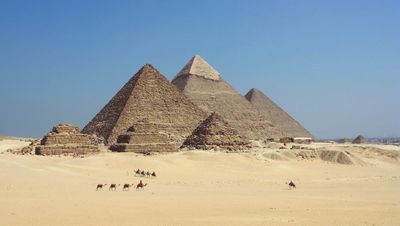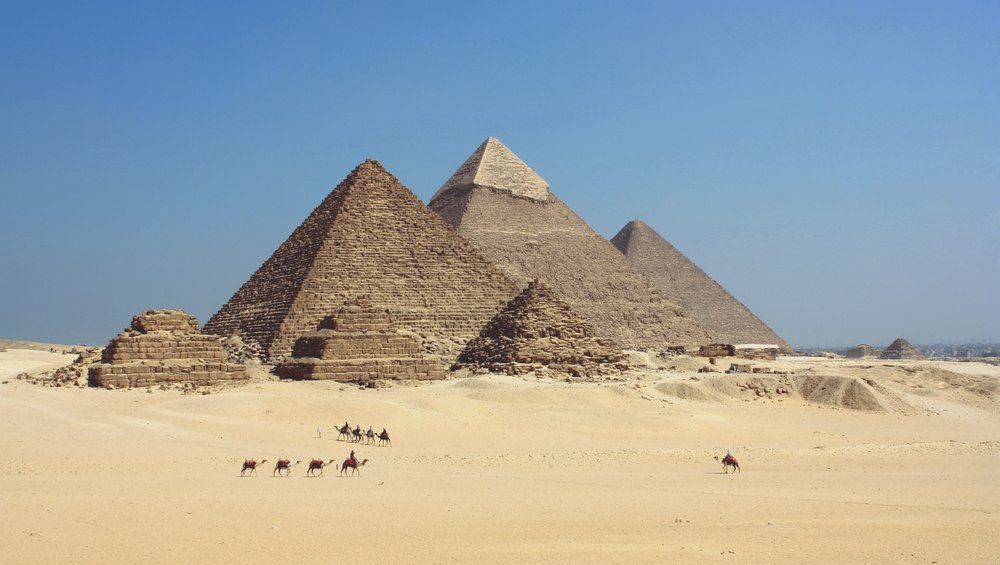Wonders of human genius, the pyramids of Egypt form a geographically and historically coherent whole. They were built by a civilization that has disappeared today, a civilization born of an arid land, which has invented a way of life, a religion, a future. As time passed, the building techniques they used were improved, and when the time came, they wanted to build perfect, smooth-faced, well-proportioned pyramids. The yards lasted for years, the number of workers was spectacular, but they arrived there: For a few centuries, at a distant time, the Egyptians of antiquity managed to build these pyramids.

Pyramids of Giza
If most are in ruins nowadays, we are lucky to be able to see some of them, including several of the giant period, a period that saw the construction of the largest monuments in the world, and that remained until the nineteenth century, when building techniques made it possible to build even taller, even larger monuments. But for most of the world's history, the Egyptian pyramids were the largest monuments in the world, failing to be surpassed.
Historical context
If we look at the history of ancient Egypt, we find that it consists of three major periods, the old empire (-3150 to -2181), the Middle Kingdom (-2160 to -1786) and the new empire (-1530 to -1069), three periods separated by intermediate periods of dislocation of the empire or its taking in hand by external forces, all preceded and followed by other moments in history.
The pyramids were built during the old empire, between the 3rd to the 6th dynasties. They are an evolution of the royal tombs that are called mastabas and which are rectangular complexes buried or semi-buried. It is the pharaoh Djoser who received the first evolution of the mastaba, namely a succession of mastabas superimposed smaller and smaller, forming a step pyramid.
Subsequently the Egyptians improved the architecture of these pyramids to degrees and tried, initially unsuccessfully, to make a pyramid with smooth faces. They succeed at the beginning of the IVth Dynasty, and very soon the period of the giant pyramids appeared. It was followed by a normalization of these pyramids, before undergoing some evolutions and disappearing at the end of the 6th Dynasty, towards the end of the old empire.
The Pharaohs built other pyramids later, which must be seen as a rebound of this tradition (twelfth and thirteenth dynasty, then seventeenth and eighteenth)
Learn more about the historical context of the pyramids.
Evolution of the pyramids
To look quickly, there is nothing that looks more like a pyramid of Egypt than another pyramid of Egypt. And yet, there are major differences between them, especially in the early days, before the normalization that will be similar, little by little, all the pyramids of the end of time.
The pyramids are born from the will to superpose several mastabas. It is Imhotep, the architect-doctor-priest of Pharaoh Djoser (Third Dynasty) who first proposed this innovative scheme. It was not a global project, perfectly defined from the beginning of the project but rather an evolution. Indeed, Imhotep built above all a large mastaba to serve as a tomb to Pharaoh. Once finished, he had it enlarged, then he superimposed a second mastaba, smaller. He later continued his work by adding a pyramid to degrees above, encompassing both mastabas in the mass of his pyramid. Then he enlarges again.
His successors will try to make pyramids by smoothing the faces. It is much more difficult to do of course, and it will take some abortive attempts (mainly under Pharaoh Snefrou) for the red pyramid to be built. It is the very first smooth-faced pyramid in the history of ancient Egypt.
Thereafter the period of the giant pyramids begins, with the famous pyramids of Khufu and that of Khafra, the necropolis of Giza. The next phase will be a return to more modest sizes and a standardized structure of the funeral complexes of the pharaohs. Then will come the time of the text pyramids, and finally the twilight of the age of the pyramids, with their abandonment pure and simple.
Learn more about the evolution of the pyramids of Egypt.
Construction of pyramids
This is a fascinating question: How could the pyramids of Egypt be built with technologies as archaic as those of this civilization?
In fact, there are several answers to that. On the one hand technically, they are quite simple, it is only a flattening of ground, then a superposition of stones cut to make the pyramid itself, then it is necessary to build all the buildings proper to the pharaonic burials like temples, warehouse rooms, ancillary buildings, enclosures, etc. The most complex parts are the galleries and internal chambers, and the very precise calculations that were needed, there are the real challenges faced by the Egyptians of the time. But the construction techniques were rather rudimentary: Masses and chisels to extract and cut stones, wooden sledges to move them. No invention of cranes, scaffolding or other lifting devices, nothing but very simple.
On the other hand, one must imagine how they could climb so high stones so heavy. There are several theories on this subject, some of which have been validated by archeology. The most common are to use brick and wooden ramps to reach the different tiers on which the workers worked.
It should be known that the workers who worked on the royal shipyards were wage earners, paid and fed by the administration, it was not, as originally thought, slaves. Evidence has been provided by field archaeological studies, particularly at the site of the workers' village on the Giza Plateau.
Learn more about the construction of the pyramids of Egypt.
Construction materials
Do you know what the Pyramids of Egypt are made of?
Well, it is obvious, it is well in limestone extracted from local quarries, quite simply. The Egyptians have not been searching for stones in remote places, it would have been useless. On the other hand, when we know that a pyramid is first and foremost an element of a funerary complex much larger than the pyramid itself, we may wonder what materials were used to make the whole tomb. And there are some different materials, though quite classic: granite, which came from the quarries of southern Egypt, wood, raw brick, rammed earth, and alabaster for the beauty of this stone. Some statues found on site are in diorite, a very hard black stone.
Learn more about the construction materials.
Maps and dimensions
When we look at a map of existing or existing Egyptian pyramids, those that are listed and large enough to be counted in a list of Egyptian monuments, we can see that they are almost all in the same part of the country: South of the Nile delta, that is to say in Cairo and in the 60 Kms south of the city. They are in necropolis with known names: Giza, Saqqara, Dahshur, Abusir, etc.
More details on the location of the pyramids of Egypt.
When to know their dimensions, well ... it's quite simple, they have all been analyzed from every angle, at least externally, and even if a large part are still to explore, we still know their dimensions. The heights and widths of their bases are in the list of the pyramids of Egypt, but you have much more information here on the dimensions of the pyramids: Numbers of steps, heights of the time and now, inclinations, etc.
Discover ...
Want to see pictures: It's here!
Want to know more about movies showing the pyramids of Egypt: It's this way!
You want to know where we can see copies, replicas of the pyramids of Egypt: See here instead! You will also find copies of the Sphinx in places you do not expect.





















